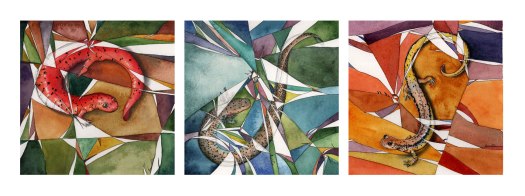
When zookeepers discovered that flamingos need a large flock in order to breed, it led to all kinds of creative approaches to fool the birds – mirrors, plastic yard ornaments, speakers playing bird-crowd sounds (now, zoos generally just keep more birds). I think of habitat loss and fragmentation like a flock of flamingos. There’s a certain amount required for the habitat to function properly. If the size is too small or divided, it will fail.
The Atlantic Longleaf Pine Ecosystem (a.k.a. pine barrens – a deceptive name considering the high amount of biodiversity) spanned over 35 million hectares (about the size of Germany) around the year 1500; today, only ~1 million hectares of pocket forests remain. (1)
Good news though! If habitat is restored, amphibians (including those pictured above plus Mabee’s salamander), among many other species, come back too. (2)
- D.H. Van Lear et al. 2005. History and restoration of the longleaf pine-grassland
ecosystem. Forest Ecology and Management 211:150–165 - J. C. Mitchell. 2016. Restored Wetlands in Mid-Atlantic Agricultural Landscapes Enhance Species Richness of Amphibian Assemblages. Journal of Fish and Wildlife Management. 7(2) 490-498








 A ring species includes a series of populations set around a large barrier. Each population is a little different from its neighbors, but those differences add up as the distance increases. So, as the populations meet each other on the other side of the barrier, they’ve built up so many differences that they no longer breed. It’s a wonderful example of evolution (parapatric speciation, if you’re interested).
A ring species includes a series of populations set around a large barrier. Each population is a little different from its neighbors, but those differences add up as the distance increases. So, as the populations meet each other on the other side of the barrier, they’ve built up so many differences that they no longer breed. It’s a wonderful example of evolution (parapatric speciation, if you’re interested).